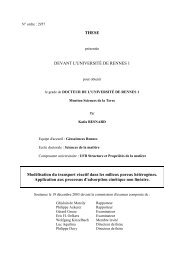Paysages virtuels et analyse de scénarios pour évaluer les impacts ...
Paysages virtuels et analyse de scénarios pour évaluer les impacts ...
Paysages virtuels et analyse de scénarios pour évaluer les impacts ...
You also want an ePaper? Increase the reach of your titles
YUMPU automatically turns print PDFs into web optimized ePapers that Google loves.
1996; Wu and Webster, 1998; Verburg <strong>et</strong> al., 2004), and explicitly rule-based mo<strong>de</strong>ls (Thornton and Jones,<br />
1998; Largouët and Cordier, 2001; Gaucherel <strong>et</strong> al., 2006a) require arbitrary <strong>de</strong>cisions and strong expertise<br />
(Li and Yeh, 2002; Hou<strong>et</strong> and Hubert-Moy, 2006). Generalized linear mo<strong>de</strong>ls (Aspinall <strong>et</strong> al., 2004; Huang <strong>et</strong><br />
al., 2007) rely on param<strong>et</strong>ric hypotheses and are obscure to interpr<strong>et</strong>, which complicates the <strong>de</strong>sign of new<br />
landcover change scenarios. On the contrary, <strong>de</strong>cision trees (DT) are non-param<strong>et</strong>ric m<strong>et</strong>hods known to be<br />
efficient without param<strong>et</strong>er tuning, accessible and useful for non-experts (Quinlan, 1981; Breiman <strong>et</strong> al.,<br />
1984; Murthy, 1998; Perlich <strong>et</strong> al., 2003). In the field of landcover mo<strong>de</strong>ling, DT are mainly used as<br />
classification tools based on remotely sensed data, pedological and geomorphological factors, or spatial<br />
<strong>de</strong>scriptors of the farm territory (Lynn <strong>et</strong> al., 1995; DeFries and Chan, 2000; Friedl <strong>et</strong> al., 2002; Lawrence <strong>et</strong><br />
al., 2004; Thenail and Baudry, 2004). Although DT have been used to simulate iterative temporal processes<br />
in other research fields (Gladwin, 1989; Hei<strong>de</strong>nberger, 1996; Jordan <strong>et</strong> al., 1997; Hazen, 2002; Tarim <strong>et</strong> al.,<br />
2006), such applications of DT have not y<strong>et</strong> been done in landcover change mo<strong>de</strong>ling, to our knowledge.<br />
Our objectives were to bridge the gap b<strong>et</strong>ween exploratory approaches and crop transition mo<strong>de</strong>ling by<br />
inferring stochastic <strong>de</strong>cision trees trained by a data-mining analysis of a crop transition learning datas<strong>et</strong>, and<br />
to use them to simulate crop transitions over several <strong>de</strong>ca<strong>de</strong>s with the incorporated agronomic driving<br />
factors. These objectives involved the following steps: (1) to i<strong>de</strong>ntify relevant driving factors of crop<br />
transition on an agricultural catchment, (2) to build a crop transition mo<strong>de</strong>l based on stochastic <strong>de</strong>cision trees<br />
(named Stochastree hereafter) and simulate summer crop transition while accounting for agronomic driving<br />
factors, (3) to evaluate the abilities of Stochastree and a reference temporal first-or<strong>de</strong>r Markov chain mo<strong>de</strong>l<br />
(named Rotomatrix hereafter) to comply with agronomic constraints. Finally, we discuss the structure of the<br />
mo<strong>de</strong>ls and the mutual benefits of a compared evaluation of Stochastree and Rotomatrix simulations.<br />
III. Stochastree, un modèle <strong>de</strong> successions <strong>de</strong> cultures basé sur <strong>de</strong>s arbres <strong>de</strong> décision stochastique – p. 73



